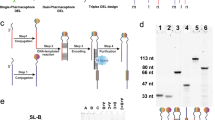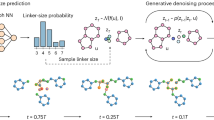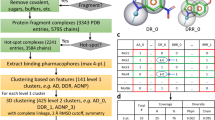Abstract
The linking together of molecular fragments that bind to adjacent sites on an enzyme can lead to high-affinity inhibitors. Ideally, this strategy would use linkers that do not perturb the optimal binding geometries of the fragments and do not have excessive conformational flexibility that would increase the entropic penalty of binding. In reality, these aims are seldom realized owing to limitations in linker chemistry. Here we systematically explore the energetic and structural effects of rigid and flexible linkers on the binding of a fragment-based inhibitor of human uracil DNA glycosylase. Analysis of the free energies of binding in combination with cocrystal structures shows that the flexibility and strain of a given linker can have a substantial impact on binding affinity even when the binding fragments are optimally positioned. Such effects are not apparent from inspection of structures and underscore the importance of linker optimization in fragment-based drug discovery efforts.
This is a preview of subscription content, access via your institution
Access options
Subscribe to this journal
Receive 12 print issues and online access
$259.00 per year
only $21.58 per issue
Buy this article
- Purchase on Springer Link
- Instant access to full article PDF
Prices may be subject to local taxes which are calculated during checkout




Similar content being viewed by others
References
Erlanson, D.A., Wells, J.A. & Braisted, A.C. Tethering: fragment-based drug discovery. Annu. Rev. Biophys. Biomol. Struct. 33, 199–223 (2004).
Hann, M.M., Leach, A.R. & Harper, G. Molecular complexity and its impact on the probability of finding leads for drug discovery. J. Chem. Inf. Comput. Sci. 41, 856–864 (2001).
Jencks, W.P. On the attribution and additivity of binding energies. Proc. Natl. Acad. Sci. USA 78, 4046–4050 (1981).
Murray, C.W. & Verdonk, M.L. The consequences of translational and rotational entropy lost by small molecules on binding to proteins. J. Comput. Aided Mol. Des. 16, 741–753 (2002).
Jiang, Y.L., Krosky, D.J., Seiple, L. & Stivers, J.T. Uracil-directed ligand tethering: an efficient strategy for uracil DNA glycosylase (UNG) inhibitor development. J. Am. Chem. Soc. 127, 17412–17420 (2005).
Krosky, D.J. et al. Mimicking damaged DNA with a small molecule inhibitor of human UNG2. Nucleic Acids Res. 34, 5872–5879 (2006).
Jiang, Y.L., Chung, S., Krosky, D.J. & Stivers, J.T. Synthesis and high-throughput evaluation of triskelion uracil libraries for inhibition of human dUTPase and UNG2. Bioorg. Med. Chem. 14, 5666–5672 (2006).
Priet, S., Sire, J. & Querat, G. Uracils as a cellular weapon against viruses and mechanisms of viral escape. Curr. HIV Res. 4, 31–42 (2006).
Fleischmann, J., Kremmer, E., Greenspan, J.S., Grasser, F.A. & Niedobitek, G. Expression of viral and human dUTPase in Epstein-Barr virus-associated diseases. J. Med. Virol. 68, 568–573 (2002).
Seiple, L., Jaruga, P., Dizdaroglu, M. & Stivers, J.T. Linking uracil base excision repair and 5-fluorouracil toxicity in yeast. Nucleic Acids Res. 34, 140–151 (2006).
Fleischmann, J. et al. Expression of deoxyuridine triphosphatase (dUTPase) in colorectal tumours. Int. J. Cancer 84, 614–617 (1999).
Hagen, L. et al. Genomic uracil and human disease. Exp. Cell Res. 312, 2666–2672 (2006).
Pasqualucci, L. et al. Expression of the AID Protein in normal and neoplastic B-cells. Blood 104, 3318–3325 (2004).
Ramiro, A.R. et al. Role of genomic instability and p53 in AID-induced c-myc-Igh translocations. Nature 440, 105–109 (2006).
Maly, D.J., Choong, I.C. & Ellman, J.A. Combinatorial target-guided ligand assembly: identification of potent subtype-selective c-Src inhibitors. Proc. Natl. Acad. Sci. USA 97, 2419–2424 (2000).
Xiao, G. et al. Crystal structure of Escherichia coli uracil DNA glycosylase and its complexes with uracil and glycerol: structure and glycosylase mechanism revisited. Proteins 35, 13–24 (1999).
Baltas, M. et al. Aminolysis of sulfinamoyl-esters, -sulfonamides and -sulfones. Thiooxamate and thiourea formation via a suifine intermediate. Thiophilic or carbophilic reaction? Tetrahedron 52, 14865–14876 (1996).
Page, M.I. & Jencks, W.P. Entropic contributions to rate accelerations in enzymic and intramolecular reactions and the chelate effect. Proc. Natl. Acad. Sci. USA 68, 1678–1683 (1971).
Böhm, H.J. The development of a simple empirical scoring function to estimate the binding constant for a protein-ligand complex of known three-dimensional structure. J. Comput. Aided Mol. Des. 8, 243–256 (1994).
Böhm, H.J. Prediction of binding constants of protein ligands: a fast method for the prioritization of hits obtained from de novo design or 3D database search programs. J. Comput. Aided Mol. Des. 12, 309–323 (1998).
Erlanson, D.A. Fragment-based lead discovery: a chemical update. Curr. Opin. Biotechnol. 17, 643–652 (2006).
Shuker, S.B., Hajduk, P.J., Meadows, R.P. & Fesik, S.W. Discovering high-affinity ligands for proteins: SAR by NMR. Science 274, 1531–1534 (1996).
Babaoglu, K. & Shoichet, B.K. Deconstructing fragment-based inhibitor discovery. Nat. Chem. Biol. 2, 720–723 (2006).
Finkelstein, A.V. & Janin, J. The price of lost freedom: entropy of bimolecular complex formation. Protein Eng. 3, 1–3 (1989).
Gilson, M.K., Given, J.A., Bush, B.L. & McCammon, J.A. The statistical-thermodynamic basis for computation of binding affinities: a critical review. Biophys. J 72, 1047–1069 (1997).
Acknowledgements
This work was supported by US National Institutes of Health grants GM56834-12 to J.T.S. and GM066895 to L.M.A. and by a Ruth L. Kirschstein National Research Service Award (F31 GM083623) to J.B.P. The content of the publication does not necessarily reflect the views or policies of the US Department of Health and Human Services, nor does the mention of trade names, commercial products or organizations imply endorsement by the US Government.
Author information
Authors and Affiliations
Contributions
S.C. performed chemical syntheses, binding measurements and energetic analysis; J.B.P. purified protein samples, crystallized the ligand-protein complexes and performed isothermal titration calorimetry; M.B. collected and analyzed X-ray diffraction data; L.M.A. contributed to data analysis and interpretation; J.T.S. analyzed the data and wrote the paper.
Corresponding author
Supplementary information
Supplementary Text and Figures
Supplementary Figures 1–4, Supplementary Schemes 1 and 2, Supplementary Table 1 and Supplementary Methods (PDF 528 kb)
Rights and permissions
About this article
Cite this article
Chung, S., Parker, J., Bianchet, M. et al. Impact of linker strain and flexibility in the design of a fragment-based inhibitor. Nat Chem Biol 5, 407–413 (2009). https://doi.org/10.1038/nchembio.163
Received:
Accepted:
Published:
Issue Date:
DOI: https://doi.org/10.1038/nchembio.163
This article is cited by
-
Protein-templated ligand discovery via the selection of DNA-encoded dynamic libraries
Nature Chemistry (2024)
-
Fragment-based discovery of a new family of non-peptidic small-molecule cyclophilin inhibitors with potent antiviral activities
Nature Communications (2016)
-
Conductivity of carbon-based molecular junctions from ab-initio methods
Frontiers of Physics (2014)
-
Fragment-based drug discovery using NMR spectroscopy
Journal of Biomolecular NMR (2013)
-
A fragment-based approach to the SAMPL3 Challenge
Journal of Computer-Aided Molecular Design (2012)



